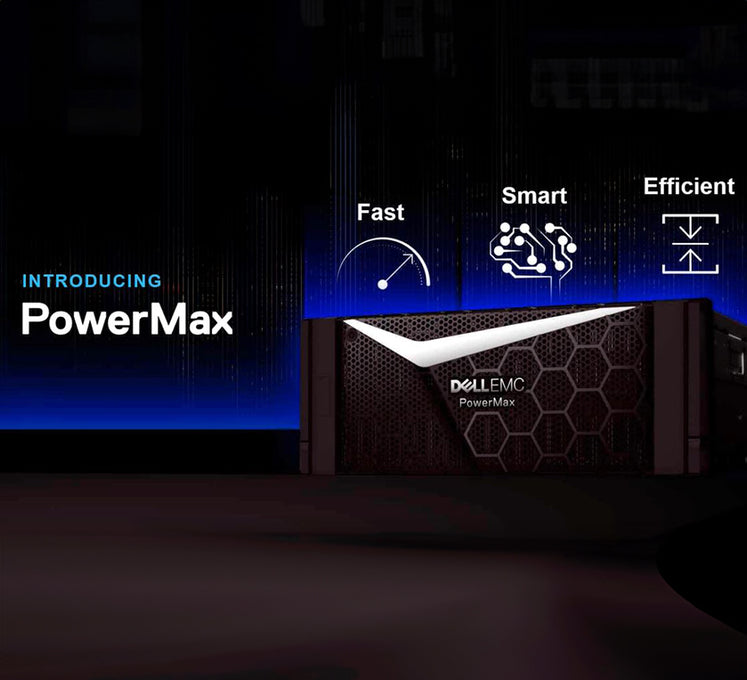PowerMax Family: Unmatched Performance and Consolidation for Enterprise Storageology choice for IoT long-range applications

PowerMax Family: Unmatched Performance and Consolidation for Enterprise Storage
The PowerMax family from Dell EMC has long been recognized as a leader in enterprise storage solutions. With the introduction of the PowerMax 2000 and 8000 arrays, Dell EMC continues to raise the bar for performance, consolidation, and data security. These new enhancements deliver unmatched levels of speed and efficiency, making them ideal for high-value, high-demand workloads of today and tomorrow.
Unleashing the Power of NVMe and SCM
One of the standout features of the PowerMax family is its support for 32Gb/s FC-NVMe, enabling end-to-end NVMe capabilities. This technology, coupled with Storage Class Memory Drives (SCM), powered by dual-port Intel Optane drives, provides a significant reduction in system latencies by up to 50%. The result is a storage solution that can deliver data at speeds measured in microseconds, rather than milliseconds.
PowerMax arrays also feature real-time machine learning, utilizing pattern recognition and automated data placement to optimize storage performance. This intelligent system ensures that data is stored and accessed with minimal latency, without any additional overhead.
Unparalleled Data Security
Data security is a top priority for enterprises, and the PowerMax family addresses this concern with its comprehensive encryption capabilities. The PowerMax 2000 and 8000 support end-to-end efficient encryption, ensuring that data remains protected from the host to the storage media. This encryption is achieved through an encryption agent on the host, coupled with a hardware-based encryption option on the array. Importantly, this encryption does not compromise the data reduction capabilities of the PowerMax arrays, such as compression and deduplication.
In addition to efficient encryption, the PowerMax family also supports Data at Rest Encryption (D@RE), providing true end-to-end data security. By combining these two encryption methods, enterprises can have peace of mind knowing that their data is fully protected throughout its lifecycle.
Unmatched Availability and Scalability
The PowerMax arrays are designed to provide unparalleled levels of availability and scalability, making them ideal for mission-critical environments. A single PowerMax Brick can achieve six nines (99.9999%) of availability, ensuring that data is always accessible and downtime is minimized. This level of reliability is achieved through the use of powerful Intel Xeon processors and active-active controller arrays.
The PowerMax 2000 and 8000 arrays offer impressive scalability options. The PowerMax 2000 can fit two Bricks in half of a standard 19" rack, while the PowerMax 8000 takes space efficiency to a whole new level by housing up to four Bricks in a single cabinet and up to eight Bricks in just two floor tiles. This compact design allows enterprises to maximize their storage capacity while minimizing the physical footprint.
Comprehensive Configuration Options
The PowerMax arrays come fully pre-configured from the factory, reducing the time to first I/O and simplifying the deployment process. Depending on the model, PowerMax arrays can support Open Systems, Mainframe, IBM i, and File all on the same array. This flexibility makes PowerMax an ideal choice for organizations with diverse storage needs, allowing them to consolidate their infrastructure and streamline management.
Specifications of PowerMax 2000 and 8000 Arrays
To better understand the capabilities of the PowerMax 2000 and 8000 arrays, let's take a closer look at their specifications:
Appliance-based Packaging
PowerMax storage building blocks are defined by appliance-based entities called Bricks. Each Brick includes an engine with two PowerMax directors, packaged software, cache, and 24-slot Drive Array Enclosures. PowerMax arrays are available in two software packages: the standard "Essentials" package and the application-rich "Pro" package, providing customers with flexible options.
NVMe and SCM Drive Capacity
Both the PowerMax 2000 and 8000 arrays support additional NVMe drive capacity through Flash capacity packs. The PowerMax 2000 can achieve a total usable capacity of 1.2 PBe, while the PowerMax 8000 can reach up to 4.5 PBe when global, inline compression, and deduplication are enabled.
Cache and Drive Options
The PowerMax 2000 is equipped with an Intel Xeon E5-2650-v4 processor with 12 cores, while the PowerMax 8000 boasts an Intel Xeon E5-2697-v4 processor with 18 cores. The cache system offers a minimum of 512 GB and a maximum of 4 TB, depending on the engine configuration. Both arrays support NVMe and SCM drives with various capacities, providing customers with options to suit their specific storage needs.
Front-End I/O Modules and Protocols
The PowerMax arrays support a wide range of front-end I/O modules and protocols. These include 32 Gb/s FC, 16 Gb/s FC, 10 GbE (iSCSI and SRDF), 25 GbE (iSCSI and SRDF), and 16 Gb/s FICON for mainframe connectivity. The number of front-end I/O modules per Brick varies, with a maximum of eight modules for the PowerMax 2000 and 16 modules for the PowerMax 8000.
eNAS I/O Modules and Software Data Movers
For customers requiring NAS capabilities, the PowerMax arrays offer eNAS I/O modules. The PowerMax 2000 supports up to 36 eNAS I/O modules, while the PowerMax 8000 can accommodate up to 87 modules. These modules provide connectivity options such as 10 GbE optical and copper ports, as well as 8 Gb/s FC ports for tape backup.
Power Consumption and Physical Specifications
The power consumption and heat dissipation of the PowerMax arrays vary depending on the configuration. The PowerMax 2000 consumes a maximum of 8.52 kVA, while the PowerMax 8000 can consume up to 32.81 kVA. The physical dimensions and weight also differ, with the PowerMax 2000 measuring 75 inches in height and weighing 1610 lbs, and the PowerMax 8000 measuring 75 inches in height and weighing 1525 lbs.
Conclusion
The PowerMax family from Dell EMC continues to set the standard for enterprise storage solutions. With the PowerMax 2000 and 8000 arrays, enterprises can expect unmatched levels of performance, consolidation, and data security. These arrays leverage NVMe and SCM technologies to deliver ultra-low latencies, while also providing comprehensive encryption capabilities to protect sensitive data. With their scalability options, configuration flexibility, and reliability, the PowerMax arrays are an indispensable asset for organizations seeking high-performance storage solutions.

